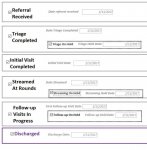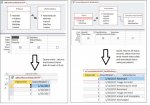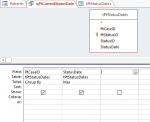I have been pouring over this for some time, and keep thinking I have found the solution.
In my main Patients table, I have:
- a single field for patient status code (9 numerical options, entered via a form option group)
- 9 separate fields for status date - one for each status (example, ReferralDate, TriageCompletedDate, etc). Each of the date fields is automatically filled when that status is selected, and users can manually update them if needed. This is all working perfectly, and I really need to have these 9 separate fields so that they can all be displayed and manually updated on the form.
In my linked reference table, I have:
- patient status code (#1-9)
- patient status name (text version of the matching patient status- to appear on reports)
- status date
How do I link the 9 status dates, which are now in 9 separate fields, to the matching status date row on my reference table?
So, I want it to read in as follows in the date field on my reference table:
- Status date for status #1 = the value entered in the ReferralDate field for that patient
- Status date for status #2 = the value entered in the TriageCompletedDate field for that patient
- Etc. All the way up to status option #9.
Do I put a query right in the date field on my reference table to pull the data in from the other 9 fields on my main table? Or do I trash the reference table date field altogether, and make a query to pull the 9 separate status date fields into the appropriate columns for a report?
I am not a programmer. It would help if I could see examples, or at least specific names of functions, and then I can look up the appropriate code. Thanks in advance for any help you can offer. I've attached a picture.
In my main Patients table, I have:
- a single field for patient status code (9 numerical options, entered via a form option group)
- 9 separate fields for status date - one for each status (example, ReferralDate, TriageCompletedDate, etc). Each of the date fields is automatically filled when that status is selected, and users can manually update them if needed. This is all working perfectly, and I really need to have these 9 separate fields so that they can all be displayed and manually updated on the form.
In my linked reference table, I have:
- patient status code (#1-9)
- patient status name (text version of the matching patient status- to appear on reports)
- status date
How do I link the 9 status dates, which are now in 9 separate fields, to the matching status date row on my reference table?
So, I want it to read in as follows in the date field on my reference table:
- Status date for status #1 = the value entered in the ReferralDate field for that patient
- Status date for status #2 = the value entered in the TriageCompletedDate field for that patient
- Etc. All the way up to status option #9.
Do I put a query right in the date field on my reference table to pull the data in from the other 9 fields on my main table? Or do I trash the reference table date field altogether, and make a query to pull the 9 separate status date fields into the appropriate columns for a report?
I am not a programmer. It would help if I could see examples, or at least specific names of functions, and then I can look up the appropriate code. Thanks in advance for any help you can offer. I've attached a picture.





